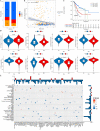Anoikis-related genes as potential prognostic biomarkers in gastric cancer: A multilevel integrative analysis and predictive therapeutic value
- PMID: 38377622
- PMCID: PMC10996445
- DOI: 10.1049/syb2.12088
Anoikis-related genes as potential prognostic biomarkers in gastric cancer: A multilevel integrative analysis and predictive therapeutic value
Abstract
Background: Gastric cancer (GC) is a frequent malignancy of the gastrointestinal tract. Exploring the potential anoikis mechanisms and pathways might facilitate GC research.
Purpose: The authors aim to determine the significance of anoikis-related genes (ARGs) in GC prognosis and explore the regulatory mechanisms in epigenetics.
Methods: After describing the genetic and transcriptional alterations of ARGs, we searched differentially expressed genes (DEGs) from the cancer genome atlas and gene expression omnibus databases to identify major cancer marker pathways. The non-negative matrix factorisation algorithm, Lasso, and Cox regression analysis were used to construct a risk model, and we validated and assessed the nomogram. Based on multiple levels and online platforms, this research evaluated the regulatory relationship of ARGs with GC.
Results: Overexpression of ARGs is associated with poor prognosis, which modulates immune signalling and promotes anti-anoikis. The consistency of the DEGs clustering with weighted gene co-expression network analysis results and the nomogram containing 10 variable genes improved the clinical applicability of ARGs. In anti-anoikis mode, cytology, histology, and epigenetics could facilitate the analysis of immunophenotypes, tumour immune microenvironment (TIME), and treatment prognosis.
Conclusion: A novel anoikis-related prognostic model for GC is constructed, and the significance of anoikis-related prognostic genes in the TIME and the metabolic pathways of tumours is initially explored.
Keywords: cancer; genetics; patient treatment.
© 2024 The Authors. IET Systems Biology published by John Wiley & Sons Ltd on behalf of The Institution of Engineering and Technology.
Conflict of interest statement
All authors have no conflicts of interest to declare.
Figures







Similar articles
-
Identification of Novel Anoikis-Related Gene Signatures to Predict the Prognosis, Immune Microenvironment, and Drug Sensitivity of Breast Cancer Patients.Cancer Control. 2024 Jan-Dec;31:10732748241288118. doi: 10.1177/10732748241288118. Cancer Control. 2024. PMID: 39340434 Free PMC article.
-
Anoikis-related genes in breast cancer patients: reliable biomarker of prognosis.BMC Cancer. 2024 Sep 19;24(1):1163. doi: 10.1186/s12885-024-12830-5. BMC Cancer. 2024. PMID: 39300389 Free PMC article.
-
An anoikis-related signature predicts prognosis and immunotherapy response in gastrointestinal cancers.Front Immunol. 2025 Feb 6;16:1477913. doi: 10.3389/fimmu.2025.1477913. eCollection 2025. Front Immunol. 2025. PMID: 39981252 Free PMC article.
-
A novel stratification framework based on anoikis-related genes for predicting the prognosis in patients with osteosarcoma.Front Immunol. 2023 Jul 27;14:1199869. doi: 10.3389/fimmu.2023.1199869. eCollection 2023. Front Immunol. 2023. PMID: 37575253 Free PMC article.
-
A novel necroptosis-related gene index for predicting prognosis and a cold tumor immune microenvironment in stomach adenocarcinoma.Front Immunol. 2022 Oct 27;13:968165. doi: 10.3389/fimmu.2022.968165. eCollection 2022. Front Immunol. 2022. PMID: 36389725 Free PMC article. Review.
Cited by
-
Anoikis resistance in gastric cancer: a comprehensive review.Cell Death Dis. 2025 Jul 15;16(1):528. doi: 10.1038/s41419-025-07860-1. Cell Death Dis. 2025. PMID: 40664635 Free PMC article. Review.
References
MeSH terms
Substances
LinkOut - more resources
Full Text Sources
Medical
Miscellaneous

